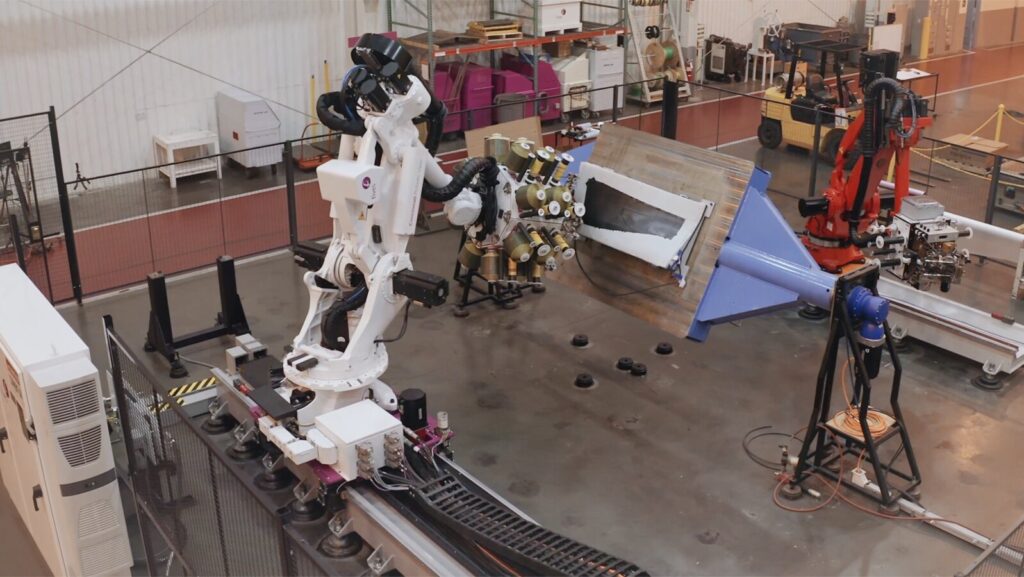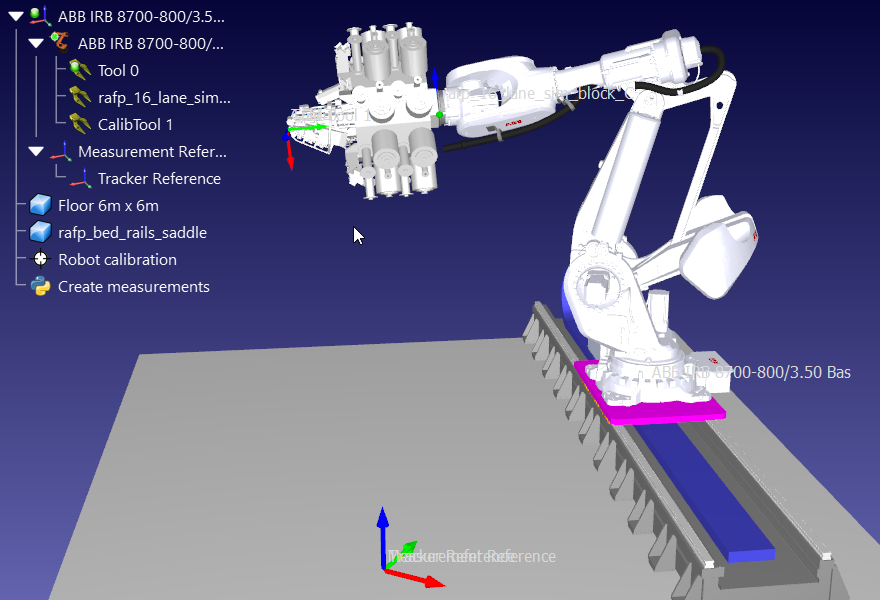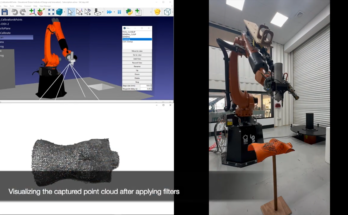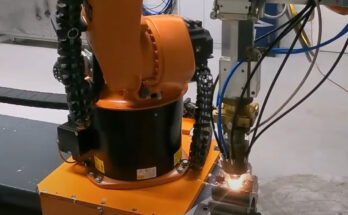Composite lay-up (a core step in the process of making a composite part) is traditionally a labor-intensive process.
The process requires skilled technicians to create the parts needed using specialized tools and equipment. This is often slow and expensive, which limits the quantity of parts that composite manufacturers can make.
The Composites & Automated Solutions group at Fives has developed a technology that allows their customers to create composite parts using a robotic fiber placement head. This technology provides a lower-cost entry point into the composite lay-up process, making it easier for manufacturers to create the parts they need.
This has the potential to significantly improve the composite lay-up process for Fives’ customers. Robotic solutions like this can help more companies to get the benefits of automation and compete in their markets.
Ultimately, this benefits the end users of the created products, in this case aerospace companies.
Here’s how Fives Group used RoboDK to create their new solution.
Why Aerospace Needs Close Tolerances for Fiber Placement
The aerospace industry has notoriously strict quality requirements and tighter tolerances than many other industries. Aircraft manufacturing involves a delicate balance between strength and weight. There is less margin for error than in other industries, where safety can be assured by a high safety factor – with an aircraft, you need to know you’re building it right.
These strict requirements make it especially necessary to use high-quality materials and manufacturing processes.
Fiber placement is one such process that requires tight tolerances. The accurate placement of fibers in a composite part is critical to the strength and durability of the finished product, such as an airplane wing.
Composites play an important role in reducing the weight of aircraft, helping to improve fuel efficiency and reduce environmental impact. Fiber-reinforced plastics are used widely in the aerospace industry because of their high strength-to-weight ratios.
A challenge is that fiber placement is a labor-intensive process. A single part can contain thousands of fibers, which would be almost impossible to place manually.
Automated fiber placement is a process where automated machinery is used to create multi-layered composite products.

Introducing Fives Group and High Precision Machines
Fives Group is a multinational industrial engineering group that offers innovative solutions and products to help major industry leaders boost their performance.
The company’s philosophy is that industry is the answer to the major issues in the modern world, such as environmental, societal, and economic challenges.
High Precision Machines group is one group within Fives. It is dedicated to developing manufacturing machinery that meets the most stringent requirements of accuracy, repeatability, and reliability.
Their technologies include solutions for material removal, composites and automated solutions, grinding, cutting, filling, sealing, and laser systems.
The group is always looking for new ways to help their customers improve their processes. This can mean creating solutions that do things differently from the existing options on the market, as with this project.
Robotic Fiber Placement
One challenge for manufacturers is that composite lay-up processes are often complex and expensive. Automation is necessary, but the cost of entry can be prohibitive for some companies and manufacturing groups.
Amanda Kotchon, Controls Engineer at Fives, explains:
We wanted to provide a lower-cost entry point into the composite lay-up market by allowing end users to quickly make complex parts to within aerospace tolerances.
To do this, the group decided to use robots for the labor-intensive process of fiber placement, in a project titled the Cincinnati Robotic Viper.
They needed to program their robots in an offline programming environment. But the problem was that the robotic systems on the market didn’t allow for accurate programming.
Kotchon continues:
When we started the project, most robot manufacturers weren’t offering accurate or corrected models of their robots.
The assumption was that your purchased robot perfectly matched the nominal geometry — which we know to be untrue.
This led to the team seeing positioning errors in the order of 1-10 mm for most off-the-shelf robots, which was not acceptable for their process. Their application required them to accurately synchronize hundreds of points at very high speeds — within milliseconds — to meet the required process speeds.
They wanted a solution that wasn’t locked into the robot manufacturer’s ecosystem.
Where RoboDK came in
RoboDK offered the team a flexible platform that gave them the accuracy and ease-of-use that they needed.
The calibration features of RoboDK were a core benefit of using the platform. Calibration is one of the platform’s powerful features. It allows you to quickly and easily improve the accuracy of almost any industrial robot.
For Fives Group, RoboDK’s calibration features gave them the control they needed to meet their tight tolerances.
Kotochon says:
RoboDK has been very helpful by not just providing calibration software, but giving us insight into the root causes of robot behavior and sources of error in the machine motion.
We appreciate RoboDK’s willingness to work side-by-side with us as we developed our application and to deep dive into robot mechanics to come up with creative solutions to new challenges.
The Team’s Robotic Setup
We always like to see how our users set up their robotic hardware and software for maximum efficiency.
Here are the components of their system:
The Robotic Hardware
The solution is based on these two core hardware components:
- An ABB IRB 8700 robot.
- A custom end effector for placing the fibers.
The Robotic Software
The core software components of the system are:
- B&R control platform. This supports easy integration with their ABB robot and also COMAU robots.
- The team’s ACES software, which determines the optimal carbon fiber placement and part geometry using the customer’s part data.
- A specially customized version of RoboDK to calibrate the robot and correct robot motions using the generated calibration.

How the System Works
The solution can produce complex curved composite parts.
To achieve the required path and position accuracy, the team begins by using the RoboDK calibration. This resolves the differences between each “as-built” industrial robot and the ideal robot model. Each robot in the system then receives its own unique corrected adjustments.
The system synchronizes 16 separate motorized tape spools and cutters with the generated robot paths. They achieve this with a combination of the robotic fiber placement head and the company’s software.
The path is synchronized with process data on the team’s B&R controller. This allows them to precisely time the thousands of input-output events that need to happen during the fiber placement process.
Who is the ideal user for Fives’ Composite Lay-Up Solution?
With this project, Fives Group aims to provide a lower-cost entry point to composite lay-up projects. Through the use of a robot arm, calibrated to aerospace tolerances.
Brent Keller, the Engineering Director of the High Precision Machines group, explains the perfect user for this solution sits in an underserved gap in the market:
This solution is ideal for an end user looking for a motion platform with position accuracy, which fills the gap between “off the shelf” robotic systems and Cartesian machine tool platforms.
In the future, the group plan to expand their use of robotic platforms in composite lay-up and automation.
In which applications do you require higher accuracy? Tell us in the comments below or join the discussion on LinkedIn, Twitter, Facebook, Instagram, or in the RoboDK Forum.. Also, check out our extensive video collection and subscribe to the RoboDK YouTube Channel




